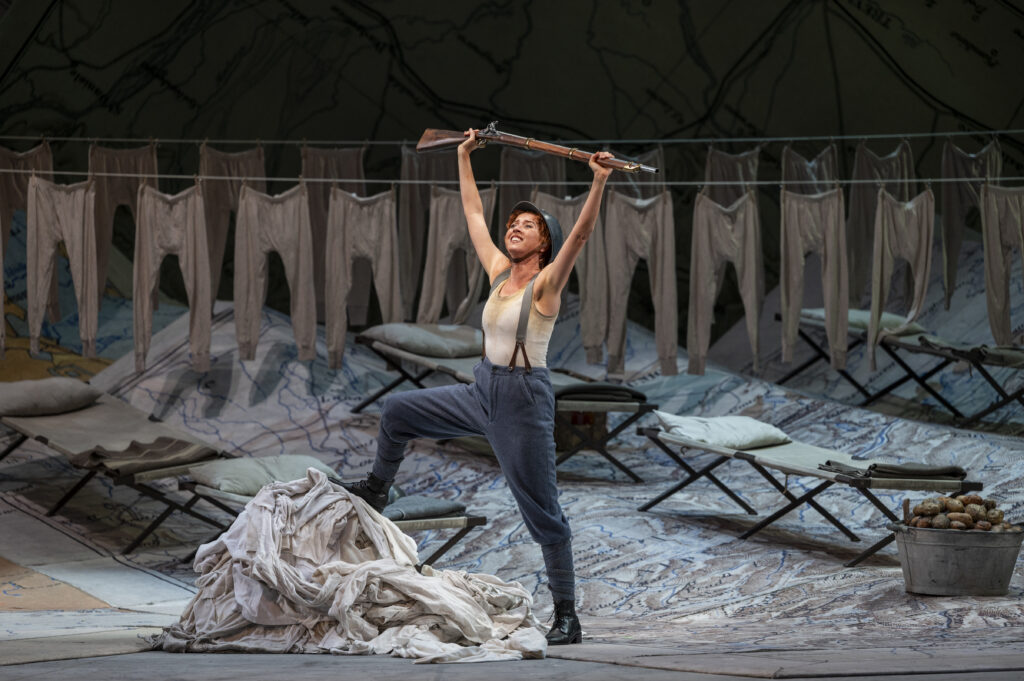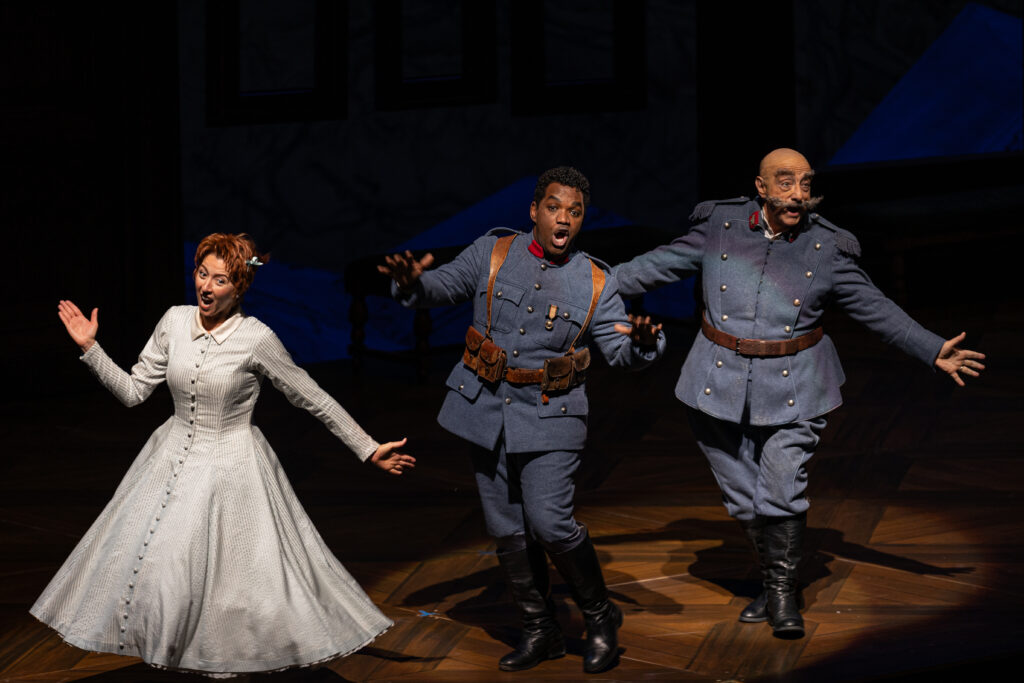The opera features an orphaned girl taken in by a unit of the French military.
‘The Daughter of the Regiment’ Conquers Lyric Opera
Returning to Chicago for the first time since 1973, Italian composer Gaetano Donizetti’s composition of the French opera performance “The Daughter of the Regiment” is a stunning addition to the Lyric Opera House until Nov. 25.
Speranza Scappucci conducts this quick-witted show filled with comedy, romance and familial camaraderie. English subtitles projected above the stage accompanied the show’s French singing.
Soprano Lisette Oropesa plays lead character Marie, an orphaned daughter taken in and raised by the 21st French Regiment, a unit of the French military. Starring in roles around the world such as Adina in “L’elisir d’amore” at the Opéra national de Paris, Oropesa is a world-renowned performer, showcasing her abilities in effortless solos in this performance.
Alongside Lyric veteran tenor Lawrence Brownlee as Tonio, the duo portrays the comedic love story between a young woman raised by soldiers and a peasant who enlists just to marry her.

The show opens in the Tyrol mountains with a chaotic ensemble of Austrian townies frantically anticipating the impending arrival of French troops. The introduction of the Marquise of Berkenfield soon breaks the worrisome tension as French troops retreat, with the Marquise making jokes about herself and the sarcastic impact of war on a woman of her financial caliber.
The singing by Grammy-nominated mezzo-soprano Ronnita Miller, portraying the Marquise, set the tone for the rest of the performance with strong vocals and powerful stage presence. The high-maintenance character of the Marquise gets swept up in the Regiment on her way to Austria with her steward Hortensius, played by Alan Higgs.
The set design resembles the elevated hills of France, patterned with a vintage map of France. This unique and functional arrangement allowed the audience to see each member of the company at differing heights on the hills in a non-distracting way. As the stage is filled with around 20 performers in some scenes, the set fulfills both aesthetic and viewing expectations by creating a balanced stage presence.
Oropesa’s introduction to the audience as Marie demonstrates a lightheartedness as the character encounters one of her many father figures, Sulpice. The two’s dynamic is loving and playful, as Sulpice encourages Marie’s love for singing and living her free-spirit life with the Regiment. Played by Alessandro Corbelli, Sulpice is a protective guardian who cherishes his only “daughter.”
Being raised by soldiers, Marie exhibits an unrefined attitude that enhances her spontaneous outlook on life. Spending her days running a canteen and singing energetic songs for the Regiment, Oropesa accurately displays Marie’s lively spirit.
Once Tonio, Marie’s love interest, is introduced to Sulpice and the rest of the soldiers, he is depicted as the overly-eager outsider who will do anything to be with her. The crowd was constantly in a state of laughter from the performer’s animated dancing and singing.
In a powerful duet between Marie and Tonio, they confess and prove their feelings for each other, prompting a long applause from the crowd and many cries of bravo. As the crowd observes the chemistry, it’s apparent that the relationship between Oropesa and Brownlee is just as comfortable and magnetic as their characters. Oropesa and Brownlee demonstrate their strong vocals, complementing the other while creating a fluid duet.
The Marquise makes another appearance, consulting with Sulpice about protection from the Regiment during her journey through war-ridden land. They soon realize the Marquise is Marie’s long-lost aunt after Sulpice recognizes the Marquise’ surname — the same one on the letter found by Marie when she was a baby. Act 1 concludes after an emotional tear-away from Marie’s family and lover by the Marquise, who plans to teach her proper manners.
The stand-out song of the first act was “Ah! mes amis” sung by Tonio. A crowd-pleaser and personal favorite, this show-stopping solo exhibits Brownlee’s natural talent and lovable personality. In a short discussion video on Lyric’s website, Brownlee explains how he has to keep a steady strong beginning, leading into nine straight high C’s to keep the audience engaged while still making a grand finale.

As the curtain rises for the second and final act, the setting conveys Marie’s new home in Austria with the Marquise a year later. The show begins to encourage more laughter as new characters are introduced, such as the Duchess of Crakentorp, portrayed by Joy Hermalyn, and her pretentious attitude.
The Duchess comes to the stage with an unapologetic attitude and luxurious over-the-top movements. She exudes comedic instinct through her facial expressions, breaking the fourth wall to engage with the crowd and conductor in the orchestra pit below the stage.
With new flashy costumes for Act 2’s affluent characters, the jokes made by the characters about their poshness or their inability to comprehend Marie’s character add another layer of comedic tone. Some used quick-witted reactions while others utilized over-exaggerated facial expressions to effortlessly draw authentic laughter from the crowd.
Training Marie to be a more proper lady suited to marry a duke, the Marquise institutes a ladylike way to sing in which her notes are straight-edge rather than improvised for enjoyment. Marie is no longer allowed to burst into eccentric songs like she could with the Regiment — instead, she is forced to keep her tone high and prim. Oropesa perfectly conveyed the attempt to sound more proper while showing the audience that her playful attitude was itching to come out between verses.
Not long into the second act, the Regiment bursts through Marie’s home in an attempt to save her and take her back to France. Sulpice and the Marquise share a playful dynamic throughout several comedic moments, one being a duet right after Marie runs off in a huff, where the audience sees each character’s big personality clash amusingly. The scenes between them seemed natural and easy for the crowd to get a laugh.
Seamlessly transitioning from comedic songs to the much needed emotional numbers and close-knit choreography between Marie, the Regiment and Tonio ultimately lead to the Marquise’s acceptance of the two marrying. Closing the show with the uplifting song “Mais o ciel! Quel bruit! Quel eclat!” by the whole cast, the show ends on a lighthearted note.
The artists then came out to send off the audience with a final laugh and a bow in front of their well deserved standing ovation.
Opera-goers can get tickets here for the remaining shows listed on their site.
Featured image courtesy of Michael Brosilow / Lyric Opera.

